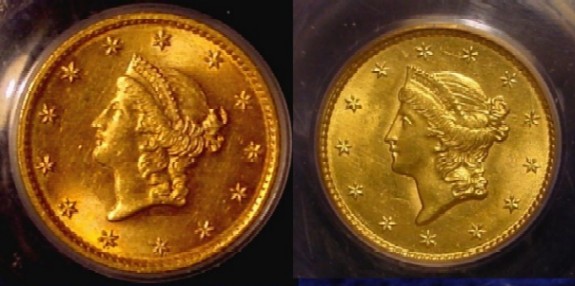Minor Gold Type coins - Type I Gold Dollar obverses
I'll admit that I have become somewhat of a gold bug. I really do enjoy nice gold coins with smooth surfaces and sharp strikes. The trouble is one has to decide what to collect once you have gotten through with the 12 piece gold type set and the earlier types that are within my financial ability.
Set collecting beyond the Indian $2.50 set is just too expensive for me. And I have standards. I really don't like gold coins that grade less than AU-50, AND I don't like baggy coins. I also don't want to have a random collection that has no real connections. So what to do?
I've found some minor gold type coins that are really fun. These types are not microscopic in nature. They are just as noticeable as items like the Type I and Type II Buffalo nickel. The trouble is that gold coins are expensive, and most collectors don’t want to or can’t commit the financial resources it takes to purchase them.
Here’s a place to start, the 1849 gold dollars. On May 8, 1849, the U.S. mint struck the first gold dollars for general circulation. Only 1,000 coins were struck, the obverse dies were different from any pieces that would follow. The head was smaller; there was no “L” (for designer James Longacre); and Ms. Liberty’s crown was placed differently between the stars.
Here is a comparison of this gold dollar subtype. These coins are scarce, but they are not that much more expensive that a “normal” Type I gold dollar. The reason is many were saved because they were the first of their kind.

"No L" type, May 8, 1849 (left) "Large Head with L" type, 1949 - 1854 (right)
Set collecting beyond the Indian $2.50 set is just too expensive for me. And I have standards. I really don't like gold coins that grade less than AU-50, AND I don't like baggy coins. I also don't want to have a random collection that has no real connections. So what to do?
I've found some minor gold type coins that are really fun. These types are not microscopic in nature. They are just as noticeable as items like the Type I and Type II Buffalo nickel. The trouble is that gold coins are expensive, and most collectors don’t want to or can’t commit the financial resources it takes to purchase them.
Here’s a place to start, the 1849 gold dollars. On May 8, 1849, the U.S. mint struck the first gold dollars for general circulation. Only 1,000 coins were struck, the obverse dies were different from any pieces that would follow. The head was smaller; there was no “L” (for designer James Longacre); and Ms. Liberty’s crown was placed differently between the stars.
Here is a comparison of this gold dollar subtype. These coins are scarce, but they are not that much more expensive that a “normal” Type I gold dollar. The reason is many were saved because they were the first of their kind.

"No L" type, May 8, 1849 (left) "Large Head with L" type, 1949 - 1854 (right)
Retired dealer and avid collector of U.S. type coins, 19th century presidential campaign medalets and selected medals. In recent years I have been working on a set of British coins - at least one coin from each king or queen who issued pieces that are collectible. I am also collecting at least one coin for each Roman emperor from Julius Caesar to ... ?
0
Comments
The one on the right is a PCGS MS-64. It's not as lustrous as some other pieces and therefore photographs well (at least for me given my imperfect talents.) I've got a very bright 1853 in PCGS MS-64 that is a great looking coin. Unfortunately the bright surfaces accentuate every mark.
All you need is one of each
My posts viewed
since 8/1/6
Experience the World through Numismatics...it's more than you can imagine.
<< <i>I like these coins but they can be a challenge to grade and predict how the TPG will grade them. >>
Actually Type 1 and Type 3 gold dollars are no different than any other gold coin up the $5 denomination when it comes to grading. The main thing is that most people need to use a 10X glass to do the job right because they are so small.
The Type 2 gold dollars present a special challenge because so many of them are poorly struck. For that reason you can't grade them on sharpness alone. Some AU and Mint State pieces, especially the branch mint coins and all of the 1855 pieces, even have dates that almost unreadable.
BTW who or what is "TPG?"
So, here's what I did:
1. Made the two images the same size.
2. Put the original images, albeit resized onto a canvas
3. Placed the large head as a third image
4. Superimposed the small head onto the large head.
To me, it's pretty cool seeing the differences, even if it is very small. Hope this helped someone else out as well and not just me!
Dennis
Like VOC Numismatics on facebook